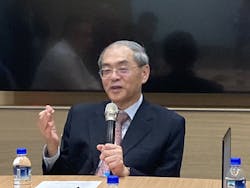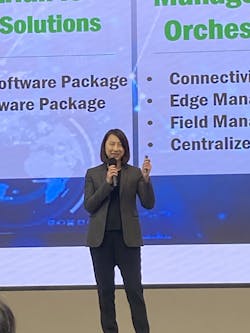Whether it happens via hardware or software, communicating data for better control and decisions is still the primary goal. So, it was no surprise that, 40 years after launching its first industrial PC, Advantech highlighted all the ways its data processing technologies have diversified and digitalized at its 2023 Industrial IoT World Partner Conference.
The celebration in late October at its newly completed AIoT Co-Creative Campus in Taipei, Taiwan, was attended by more than 800 visitors, including 300 customers from 60 countries. They were treated to comprehensive keynote sessions, tours and other presentations about Advantech’s process controls, edge computing, Internet of Things (IoT), cloud computing, artificial intelligence (AI) and all the other permutations it’s developed and continues to co-create with its many partners. They also got an update on the company’s presence and investments, including its plans to achieve net-zero emissions by 2050.
“Data is exploding with 45% of the total coming from IoT sources, so we need compact, powerful and reliable devices on the edge and decentralized AI to handle all that front-end digitalization,” said Hank Lee, corporate management and development director at Advantech. “However, no one can handle all these challenges alone, so this is where our partnerships are bringing new strengths to innovate faster, and achieve multiple impacts in manufacturing, transportation, healthcare and other industries.”
Committed background = bright future
• Edge AI that includes its Industrial AI and Mobility AI solutions;
• Industrial IoT (IIoT) digital solutions such as iFactory and iEMS software;
• Edge management and orchestration that covers connectivity and centralized services, as well as field and edge management; and
• Secure AIoT at the edge with ISA/IEC 62443 readiness and Advantech’s secure software architecture.
“This our technology path to innovative advancement from sensing devices, I/O and communications to edge computing, AI and the cloud,” said Tsai. “We think generative AI (gen AI) will bring our WISE IoT, AI Fusion and other AIoT solutions to the next level, and further enhance the more than 10,000 machines in the field that are powered by Advantech’s hardware and software. They’ll also be enabled by our new EdgeSync 360 edge-management and orchestration architecture that works with more than 200 OT-based devices from the edge to the cloud.
“Our co-creation partnerships already let us collaborate on IoT and AI innovations, but they’re also going to help us achieve a greener world during the next 40 years.”
Gen AI takes off
For instance, Deepu Talla, VP and GM of embedded and edge computing at Nvidia, reported that gen AI grew so much in the past year because the large-language models it uses transitioned from text to speech. Nvidia is a member of Advantech’s Elite Partner program, and its software runs on a variety of Advantech’s industrial PCs, servers and other devices.
“Gen AI is revolutionary because its zero-shot learning and natural language prompts enable faster development cycles, while legacy convolutional neural networks (CNN) are rigid and rule-based, require lots of labeled data, and have slow development cycles,” explained Talla during his address at the event. “Gen AI has already accumulated more than was previously possible, and will continue to take off because we can speak to it. This allows every person to interact with it and program it.”
Talla added that gen AI can enable a variety of applications, including:
• Video searches;
• Real-time asset tracking;
• Planning and navigation for autonomous vehicles;
• Teaching robots;
• Defect inspection; and
• Human-robot interaction.
“Gen AI can help find those last 1-2% of defects. In fact, it’s already beating traditional AI algorithms,” says Talla. “For instance, Nvidia has been working for five years on detecting humans in a given frame, which isn’t easy because there are so many models to deal with. However, gen AI on our Nvidia Orin platform employs one foundational model that’s based on a text or speech request, and can improve accuracy from close to 52% with a CNN to 92% with gen AI in our Transformer PeopleNet model.”
In general, Open Robot/Resource interface for the Network (ORiN) is a standard middleware specification that resolves differences in communications standards between manufacturers, versions and regions.
Talla stated the most popular of the foundational models is Llama 2, but Nvidia can also build using its Metropolis application framework, which can do post-processing for camera data and other actionable intelligence that needs post-processing. Metropolis works from the outside, but Nvidia can also work from the inside with its Isaac software platform for developing, simulating and deploying AI-enabled robots.
“Many of these capabilities are due to Nvidia’s partnership with Advantech,” added Talla. “Users can employ these and other gen AI platforms as much as they need to increase application accuracy, and speed development and time to market.”
AI accelerates at the edge
Because edge computing already brings operations technology (OT) and information technology (IT) together, Advantech reports that AI will compound its gains, and that 50% of edge computing devices will have AI capabilities by 2026. This collaboration will enable time-sensitive networking (TSN), secure communication management, wireless smart sensors and I/O, and device health maintenance using AI integrated with vibration sensors, machine vision and other components.
For example, Nvidia’s Gen AI software development kit (SDK) can run on Advantech’s Jetson Orin platform to augment data, improve search functions, and reconstruct images. Likewise, EdgeSync 360 includes:
• EdgeLink connectivity service that can connect more than 200 field devices from the edge to a cloud-computing service;
• DeviceOn edge management service that brings greater intelligence to computing platforms;
• WebAccess field management service that delivers real-time operation and visualization; and
• EdgeHub 2.0 centralized service that provides a single platform for managing all Advantech devices.
Partnering for prosperity
Despite all the innovations it’s produced during its first 40 years, Advantech’s leaders adds that advances in AI, edge computing and digitalization are emerging so rapidly that it plans to collaborate more closely with its many partners in the coming months and years.
“Since Day 1, we’ve been dedicated to industrial automation and computing. More recently, we implemented our AIoT position, and now we’re seeking even greater cooperation from all of you to co-create the future,” said K.C. Liu, founder and chairman of Advantech, during his keynote address on the conference’s second day. “We’re expecting strong growth over the next five to 10 years in all of our edge computing sub-markets as they diversify and become more complex.”
Liu reports that achieving digital transformation for its AIoT program requires a trio of co-creators and their advanced software, including:
• EdgeSync 360 and its connectivity, management and centralized services;
• AI Fusion that combines Advantech’s WISE-Vision.AI software and Edge AI partner alliance with gen AI powered by Microsoft’s Azure OpenAI service; and
• WISE-Platform as a Service (PaaS), which consists of VisualSuite dashboard and SaaS composer, DataInsight, InsightAPM, and iFactory, iEEMS, iEquipment and iCityService domain software.
“These solutions are designed to make it easier for system integrators and end user to complete their tasks with low-code or no-code,” explained Liu. “We’re also planning to launch WISE-GenAI.Fusion Copilot, which works with Microsoft’s Azure OpenAI Copilot stack architecture that has four top capabilities—content generation, summarization, code generation and sematic search. These capabilities will let WISE-GenAI.Fusion Copilot use gen AI to direct human-language notifications, assist smart-energy, -factory and -city applications, and enable sustainability over the long-term.”
About the Author

Leaders relevant to this article:


